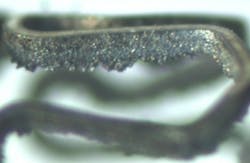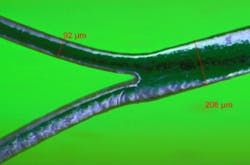BILL PEATMAN
The best of both worlds from a single platform
Prototyping has long been a challenge for manufacturers of small, precision parts. Why? Because when accuracy is measured in microns, it can be difficult to create a prototype that will be manufacturable at scale. While 3D printing has made it possible to prototype everything from tiny implantable medical devices to full-scale auto engines, creating a model with equipment and processes that are not used in production manufacturing means that manufacturability may not be possible with existing equipment, delaying time to market. In other words, rapid prototyping doesn't always lead to rapid product development.
Laser solution
Laser machining platforms have been used for prototyping for years because of the fact that setup is fast and high levels of accuracy can be achieved. Furthermore, there is no physical tool or tool wear to impact accuracy and repeatability.
Laser prototyping for micro-parts, however, has been more challenging because of significant heat-affected zone (HAZ)—thermal damage (in the form of melting, burring, or recast) that becomes burdensome for microscopic parts requiring absolute precision.
Enter the ultrafast laser. Lasers with pulse widths in the femtosecond regime have been developed that can machine without causing thermal damage. This means that prototypes of micro-parts can be made that are virtually flawless. A coronary stent sample (FIGURE 1) shows stent struts as machined with a nanosecond laser (top), while the image on the bottom is of a similar stent structure machined with a femtosecond laser.
Commercial-grade femtosecond lasers
Until recently, femtosecond lasers have shared the limitations of 3D printers for prototyping. Femtosecond lasers were fine for creating models in laboratory environments, but were not robust enough for full-scale manufacturing, and so the question of the manufacturability of prototypes remained.
This has changed in recent years with the advent of commercial-grade femtosecond lasers and manufacturing platforms that offer the stability, part handling, and beam control to deliver repeatable, precision material removal on micro-parts in a 24/7 manufacturing environment. This means that the very same tool, equipment, and process used to create a prototype can also be used to manufacture production parts at scale. FIGURE 2 shows an early femtosecond laser (top) and a CNC femtosecond laser micromachining platform (bottom).
The emergence of industrial femtosecond laser micromachining platforms has enabled new parts and new products to be designed and manufactured at an accelerated rate. Once a prototype is finalized, the time to take the prototype to volume manufacturing is greatly reduced. Examples of next-generation designs that have moved from prototypes to finished manufactured parts using femtosecond lasers include—among many others—OLED panels, fuel injector nozzles, and the aforementioned coronary stents (FIGURE 3).
Industrial femtosecond micromachining platform
In 2011, Microlution pioneered the world's first micromachining platform supporting femtosecond lasers capable of industrial use. Dubbed the ML-5, the platform features a 5-axis laser scan head, a precision ground natural granite base, ironless linear motors, Heidenhain glass scales, and palletized work-holding to deliver the kind of precision required for machining at micro-scales.
Femtosecond lasers are now available to deliver true athermal micromachining, with accuracy within a single micron and sub-micron repeatability. The technology has been proven in automotive, medical device, semiconductor, and consumer product manufacturing.
Flexible high-volume solution
One potential drawback of femtosecond lasers (and other lasers) for volume manufacturing has been manufacturing speed. Compared to volume machining processes like punching, stamping, and embossing that allow multiple parts to be machined in parallel, laser machining has been a serial process.
Another limitation of femtosecond technology is that it can typically remove small amounts of material as it machines. Therefore, machining larger features can be very slow.
BILL PEATMAN([email protected]) is with Microlution, Chicago, IL; www.microlution.com.





